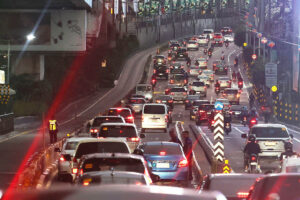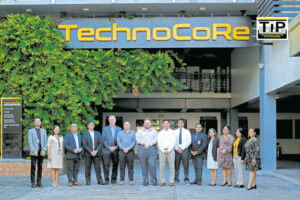Teaching Canadian kids about Pinoy food

The Mama Sita Foundation held a three-day webinar series for schoolchildren under Toronto Catholic District School Board, titled “The Evolution of Philippine Cuisine.” This was done with the collaboration of Philippine Consulate General in Toronto. On the invitation, it stated, “Do note that the webinar will be mainly for grade school and secondary school students. As such, the contents of the webinar will be catered to a younger audience.” Based on what we saw in the first lecture (“What Our Ancestors Ate”), all Filipinos of any age would be able to learn something new from the series.
The lecture consisted of videos shot especially for the lecture series, featuring a (culinary) star-studded cast: Glenda Barretto, Via Mare founder and presidential caterer; and culinary historian and author Felice Prudente Sta. Maria. Both figures focused on Ferdinand Magellan’s 1521 landing in the Philippines, during his tour that attempted to find the fabled Spice Islands and to circumnavigate the globe.
Glenda Barretto Mama Sita talk
The videos showed that the Spaniards were greeted by the natives with raw fish, coconuts, palm wine, and bananas. This according to the account of Antonio Pigafetta, the chronicler of Magellan’s voyage.
“It showed the innate generosity of the natives. They went and saw a ship full of (armed) people but they noticed they were hungry, so they took the trouble of going back and getting food to be given to the people on the ship,” said Ms. Barretto.
There was no historical record of whether they were served cooked food, but dishes like Binikol (vegetables in coconut milk with smoked mackerel) and Sinakugan (red rice porridge) may have been already present at the time, according to the video. Ms. Barretto presented a version of Sinakugan, explaining that it is made with both glutinous and red rice, coconut milk and a little bit of salt. This version was slathered with chocolate and served alongside dried fish, making this a prototype for our present champorrado (chocolate would only arrive on Philippine shores much later than 1521, at the height of the Galleon trade period).
The lectures not only gave a straightforward account of these meals, but also backed them up with lessons on Filipino values and the biting issue of local food security. A voiceover went, “Sustaining the country’s food supply is of utmost importance. Food remains the Filipino way to express hospitality and kindness.”
Felice Mama SIta Talk
Ms. Sta. Maria is an authority on the subject of the meals served during the first European contact with these islands, since she wrote a book about it (Pigafetta’s Philippine Picnic, published 2021). She said that Pigafetta recorded the production of vinegar from both coconuts and nipa 500 years ago. “It is important to sustain Philippine vinegar-making that can keep nipa (a mangrove palm) and coconut environments ecologically balanced, thriving, and prosperous,” she said.
Other dishes Pigafetta recorded included pork in broth, fish and broth, and roast fish with “freshly harvested raw ginger.” Pigafetta also recorded the raising of pigs, goats, and chickens; and the consumption of wild meats such as bats.
“The story of Antonio Pigafetta in 1521 during the first sail around the world begins the history of Philippine food and beverage. He records for posterity not only what was eaten and what could serve as provisions for a long journey, but that food security was important to ancestral Filipinos. They welcomed guests with food, they fed the hungry, and they valued the happiness every meal brings,” Ms. Sta. Maria concluded.
“Mga Kuwentong Pagkain’s webinars aim to promote Filipino culinary heritage, foodways, and cuisine to a global audience,” said Clara Reyes-Lapus, President of the Mama Sita Foundation, and member of the Reyes family behind Mama Sita in an e-mail to BusinessWorld. “Reaching out to Filipino communities overseas helps us achieve this objective because they are great ambassadors of our food,” she said .
Mama Sita condiments’ brand takes its roots from Teresita Reyes’ own efforts to bring Filipino tastes to Filipinos abroad, thus having the company’s seeds sticking to the Filipino diaspora. Ms. Reyes-Lapus said, “The Mama Sita’s brand is committed to upholding the vision of its founder and namesake who reserved her deepest affections for her family, her country, and its food. She considered food as a catalyst in nurturing relationships and bridging cultures, and always believed that Philippine cuisine was world-class. Apart from filling a gap brought on by a couple of missing ingredients in a limiting environment or achieving a distinct taste to approximate authentic flavors from the homeland, Mama Sita’s endeavors to strengthen the bonds of families and friendships, while rekindling ties to a country and culture that inhabit the soul.”
The decision to show these talks to children of the Filipino diaspora is also one that makes sense by Mama Sita’s logic. “Engaging younger generations in diasporic communities ensures sustainability and biodiversity in Philippine agriculture,” said Ms. Reyes-Lapus. For example, she mentions their champorrado kits made with heirloom rice grains from the Cordillera, as well as Philippine chocolate. “We are able to create a deeper appreciation of the value of these rice grains, their uniqueness, beauty, and high nutritional value. Hopefully this will spur demand and expand the market, which will in turn encourage farming communities in the region to continue their tradition,” she noted.
“It’s important for Filipino children in the diaspora to know their roots and develop an affinity with their culture because these are critical aspects of their identity. And food is an excellent platform to learn about culture.” — Joseph L. Garcia
![Photo of [B-SIDE Podcast] Ghost Month and the stock market](https://redstateinvestings.com/wp-content/uploads/2023/09/2023-09-11-B-side-Justine-Podcast-ART-300x300-EnE1el-300x220.jpeg)



